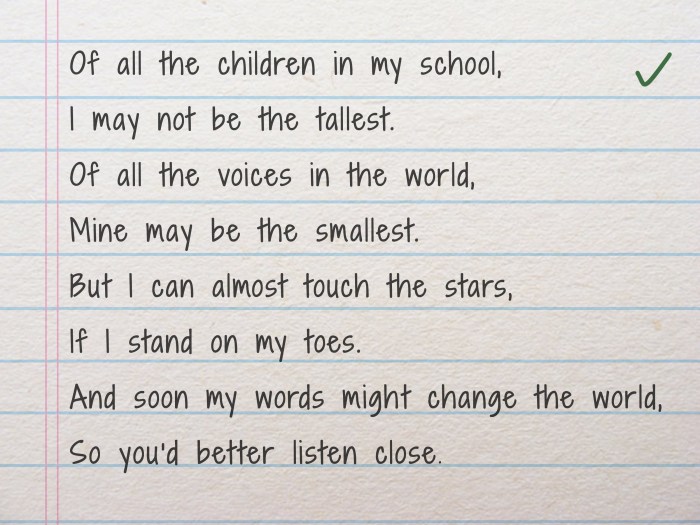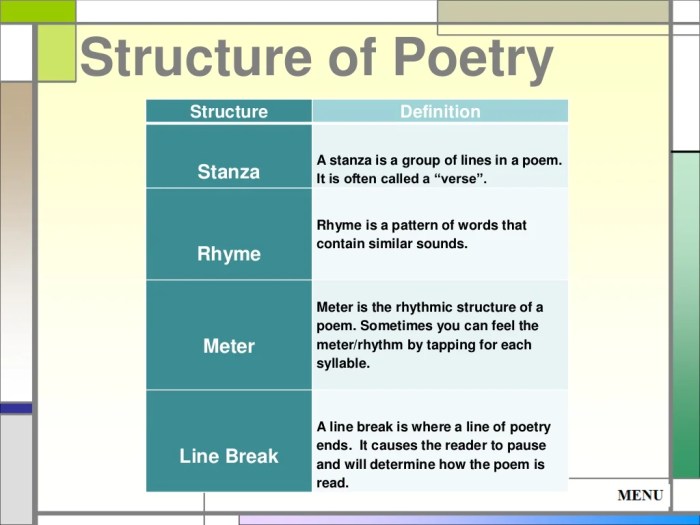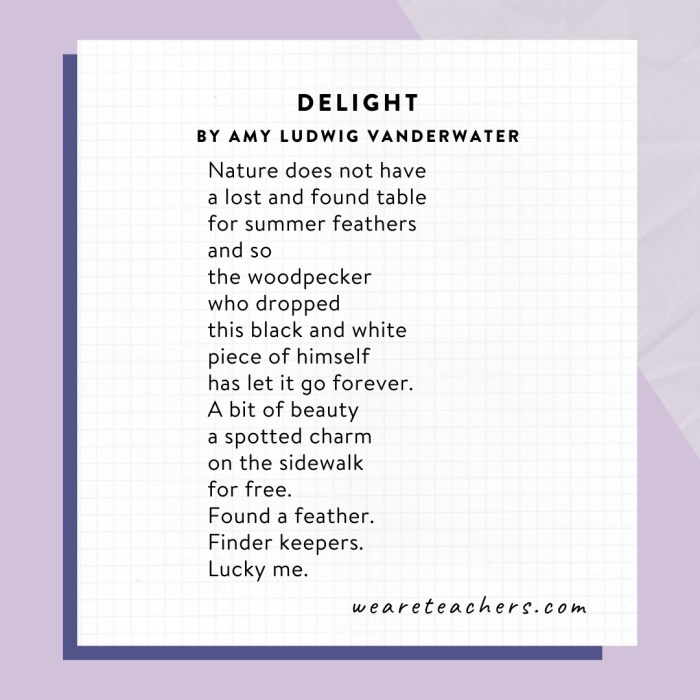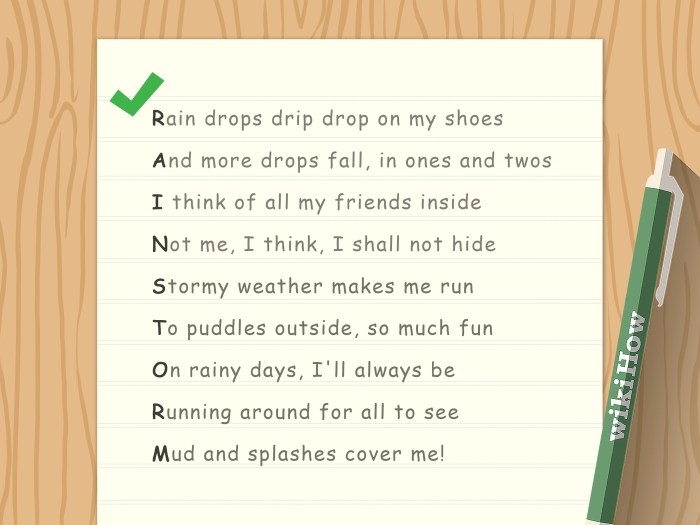Embark on a poetic journey with How to Write a Poem: 15 Poetry Forms and Techniques, delving into the intricacies of crafting beautiful verses that resonate with emotions and imagery.
Explore the world of poetry as we uncover various forms, techniques, and tips to help you unleash your creativity and pen down captivating poems.
Introduction to Poetry Forms

Poetry forms refer to the different structures or styles that poems can take on, such as sonnets, haikus, or limericks. Each form has its own set of rules regarding rhyme scheme, meter, and line length.
Understanding different poetry forms is important because it allows poets to experiment with different techniques, challenge themselves creatively, and convey their message in a more structured or innovative way. By exploring various forms, poets can discover new ways to express emotions, thoughts, and experiences through their writing.
Examples of Popular Poetry Forms
- Sonnet: A 14-line poem, typically written in iambic pentameter, with various rhyme schemes such as Shakespearean or Petrarchan.
- Haiku: A traditional Japanese form consisting of three lines with a 5-7-5 syllable pattern, often focusing on nature or a fleeting moment.
- Limerick: A humorous form with five lines, known for its AABBA rhyme scheme and witty or nonsensical content.
- Free Verse: A form that does not follow a specific rhyme scheme or meter, allowing for more flexibility and creativity in expression.
Techniques for Writing Poetry

When it comes to writing poetry, there are various techniques that poets use to create impactful and meaningful pieces. These techniques help in shaping the structure, tone, and overall message of the poem.
Rhyme Scheme, Meter, and Imagery
Understanding rhyme scheme, meter, and imagery is essential in crafting a well-rounded poem that captures the reader’s attention and emotions.
- Rhyme Scheme: A rhyme scheme is the pattern of rhymes at the end of each line in a poem. It adds a musical quality to the poem and helps in creating a sense of unity and flow.
- Meter: Meter refers to the rhythm of a poem, created through the arrangement of stressed and unstressed syllables. It contributes to the overall feel and pace of the poem.
- Imagery: Imagery involves using descriptive language to create sensory experiences for the reader. It helps in painting a vivid picture and evoking emotions.
Literary Devices: Simile, Metaphor, and Personification
Utilizing literary devices like simile, metaphor, and personification can add depth and layers of meaning to your poetry.
- Simile: A simile is a comparison between two unlike things using the words “like” or “as.” It helps in creating vivid imagery and making abstract concepts more relatable.
- Metaphor: A metaphor is a direct comparison between two unrelated things, highlighting a similarity. It can add complexity and richness to your poetry.
- Personification: Personification involves attributing human characteristics to inanimate objects or abstract ideas. This literary device can bring life and emotion to your poems.
Evoke Emotions and Create Vivid Imagery
One of the key goals of poetry is to evoke emotions and create vivid imagery that resonates with the reader. Here are some tips to achieve this:
- Use sensory language to appeal to the reader’s senses and create a sensory experience.
- Tap into universal themes and emotions that readers can relate to on a personal level.
- Experiment with different poetic forms and structures to convey your message effectively.
- Revise and edit your poems to ensure clarity, coherence, and emotional impact.
Common Poetry Forms to Explore

Poetry forms are varied and diverse, each offering a unique structure and set of rules that contribute to the overall beauty and impact of a poem. Here, we will explore five common poetry forms, including their structures, rules, and examples of famous poems written in each form for inspiration.
Sonnet
A sonnet is a 14-line poem with a specific rhyme scheme and meter. The most common forms are the Petrarchan and Shakespearean sonnets. The Petrarchan sonnet consists of an octave followed by a sestet, while the Shakespearean sonnet is divided into three quatrains and a final rhymed couplet. Sonnets typically explore themes of love, beauty, and mortality.
Example: William Shakespeare’s “Sonnet 18” (“Shall I compare thee to a summer’s day?”)
Haiku
Haiku is a traditional form of Japanese poetry that consists of three lines with a 5-7-5 syllable structure. Haiku poems often focus on nature, seasons, and fleeting moments, capturing a single vivid image or emotion.
Example: Matsuo Basho’s haiku “An old silent pond / A frog jumps into the pond— / Splash! Silence again.”
Villanelle
A villanelle is a 19-line poem with a specific rhyme scheme and repetitive refrains. It consists of five tercets followed by a quatrain, with the first and third lines of the opening tercet recurring alternately at the end of the other tercets and in the final quatrain. Villanelles often explore themes of obsession, memory, and loss.
Example: Dylan Thomas’s “Do not go gentle into that good night”
Free Verse
Free verse is a form of poetry that does not follow a specific rhyme scheme or meter. Instead, free verse relies on the natural cadences of speech and the poet’s unique voice to create rhythm and structure. Free verse poems can vary widely in form and content, allowing for freedom and experimentation.
Example: Walt Whitman’s “Song of Myself”
Sestina
A sestina is a complex 39-line poem that consists of six six-line stanzas followed by a three-line envoy. The same set of six words is repeated at the end of each line in a specific pattern, creating a sense of circularity and unity. Sestinas often explore themes of time, memory, and change.
Example: Elizabeth Bishop’s “Sestina”
Last Point

As we conclude our exploration of How to Write a Poem: 15 Poetry Forms and Techniques, remember that poetry is a powerful medium of expression that allows you to paint vivid pictures with words and evoke deep emotions with every line.